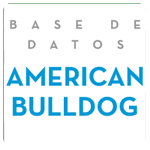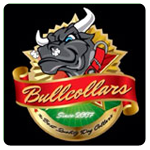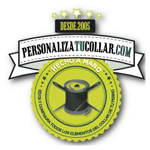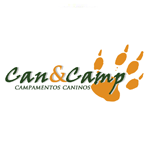
The American Bulldog is an athletic, temperamentally sound, medium to large size dog that possesses great strength, agility and confidence. The expression should reflect intelligence and alertness. The sturdy, powerful, yet compact frame is characteristically stockier and heavier boned in the males and more refined in the females. Some aloofness with strangers and assertiveness with other dogs is accepted.
**Note: The European Kennel Club judges are specifically charged with the responsibility of evaluating the temperamental stability as well as structural conformation on all dogs.
Any dog demonstrating shy or timid behaviour, or that is out of control, presenting a danger to other dogs or people, will be dismissed from the ring at the judges discretion.
In officially recognizing two distinctive types of American Bulldogs, Standard and Bully, the EKC requires that they be judged separately.
Size:
The ideal male should range from 22-26 inches at the withers.
The ideal female should range from 21-25 inches at the withers.
Standard: A leaner, more athletic dog in appearance.
Bully: A thicker, more powerful dog in appearance.
Weight should be in proportion to height in both types.
The dog should be well conditioned, not overweight or underweight.
One inch over or under the standard is a minor fault for both types.
Anything over one inch is a major fault for both types.
Colour:
Solid white, white with varying degrees of brindle, brown, red, and tan is acceptable. Solid brindle, brown, red, or tan with no visible white is a cosmetic fault. Solid black, blue, black and tan, tri colour, and any degree of merle is a disqualification. A full black mask is a major fault.
*Tri colour is white with black and tan patches.
**Merle is a dilution of overall body colour (black or red) with splotches of darker colour giving the effect of «merling», or «marbling», not to be confused wit brindle, that gives the effect of «striping».
Coat:
Short, less than one inch in length, varying from soft to stiff.
Long, feathering, or fuzzy coats are a disqualification.
Head:
The head should be relatively large and broad in proportion to the size of the dog.
It should be flat on top giving a squared appearance.
There is a defined furrow between the eyes with a distinct, deep stop.
The head is well muscled throughout with prominent cheeks.
An excessively narrow head is a major fault in both types.
Standard: Generally box to wedge shaped in appearance, with a slightly shallower stop and less wrinkles.
Bully: Generally box to round shaped in appearance, with a more definitive stop and more wrinkles.
Eyes:
The eyes should be round or almond in shape, medium size, and wide set.
Dark brown is preferred, other colours are accepted, but are a cosmetic fault.
Black eye rim pigment is preferred, other colours are accepted, but are a cosmetic fault. Crossed and/or non-symmetrical eyes are a major fault.
Visible haw is a fault based on the severity.
Muzzle:
The muzzle should be relatively broad and square.
The jaws are well muscled, displaying great strength.
Lips are full, but not pendulous.
Black pigment on the lips is preferred, other colours are accepted, but are a cosmetic fault.
An excessively narrow muzzle is a major fault in both types.
Wry jaw is a disqualification in both types.
Standard: Muzzle should be 30% to 40% of the overall length of the head.
Bully: Muzzle should be 25% to 35% of the overall length of the head.
A muzzle longer or shorter than the standard is a minor fault.
Any breathing problems displayed in the ring will be considered a disqualification.
The dog may be dismissed from the ring at the judges discretion for the welfare of the dog.
Teeth:
The teeth should number 42 and be large in size.
Small and/or crooked teeth are a minor fault.
Missing teeth are a structural fault and will be penalized.
Working dogs will not be penalized for broken teeth.
Should medical removal of teeth be needed, documentation from a veterinarian is required.
Bite:
Standard: Reverse scissors is preferred.
A scissor bite or moderate under-bite, up to 1/4 inch is acceptable.
Even bite is not preferred.
Bully: Undershot up to 1/4 inch is preferred.
1/8 to 1/2 Undershot is acceptable.
Even bite is a major fault.
Scissor bite is a disqualification.
Both Types: Anything over the accepted standard is a structural fault, and will be penalized based on the severity.
Teeth should not be visible when the mouth is closed.
Nose:
Black is the preferred colour, with shades of red or brown being acceptable.
A lack of pigment is a cosmetic fault.
Ears:
The ears should be medium in size and may be either forward flap or rose, with no preference.
Cropped ears are a cosmetic fault, due to the fact that they have been cosmetically altered and can not be judged in their natural state.
**In countries where it is illegal to crop the ears, owners must show a certification from a veterinarian for dogs that have been altered.
Neck:
The neck should be medium in length, muscular, slightly arched, and taper from shoulders to head.
Shoulders:
The shoulders should be well muscled with good definition and wide sloping blades giving the appearance of great strength.
Chest:
The chest should be deep and moderately wide giving the appearance of power and athletic ability. It should be well balanced, not excessively narrow or wide.
Body:
The body should be well balanced and compact, while powerful and athletic in appearance.
There should be a good spring of the ribs and the loin moderately tucked.
The body should not be excessively long.
Back:
The back should be broad, showing great strength, with a slight roach over the loins. The back should not be narrow or swayed.
Standard: Straighter more level top-line.
Bully: Straighter more level top-line is preferred, appearance of being slightly higher in the rear is acceptable.
Legs
Front:
The front legs should be straight with moderate to heavy bone.
Pasterns should be strong and upright.
Weak pasterns are a major fault.
Elbows that are bowed or twisted are a fault from minor to a disqualification, based on severity.
Rear:
The rear legs should be well muscled, moderately angulated and parallel. Pasterns should be strong and upright.
Weak pasterns are a major fault.
Cow-hawked is a fault from minor to a disqualification, based on the severity.
Hindquarters:
The hindquarters should not be as wide as the shoulders, but should be well balanced, thick and muscular.
Tail:
The tail is set low, thick at the base, tapering to a point.
The tail should reach the hocks in a relaxed position. Tails above or below the hocks are a minor fault.
Tails that are kinked, screw, or end in a complete circle are a fault.
Docked tails are a fault due to the fact that the tail has been cosmetically altered and can not be judged in it’s natural state.
** In countries where it is illegal to dock tails, owners must show a certification from a veterinarian for dogs that have been altered.
Feet:
The feet should be of moderate size.
The toes should be well arched and close together.
Crooked toes are a minor fault.
Splayed feet are a fault from minor to major, based on the severity.
Gait:
The American Bulldog should move smoothly with speed, power, and agility.
There should be no rolling or clumsiness.
The top-line should remain level as the front legs are reaching, and the rear legs propel the dog forward.
As speed increases the feet move towards the centre of the body for balance.
Dogs should not paddle, pace, or have a short stilted stride.
Front and/or rear legs crossing is a major fault.
Any dog showing lameness will be dismissed from the ring for the welfare of the dog.
* Dogs with disqualifying faults will not be dismissed from the ring, but will not be considered for placement.
** Note: Males without two testicles, dogs that are deaf, and dogs that have been spayed or neutered are not allowed to compete in the conformation ring.



